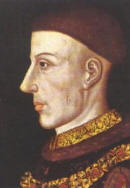Les Archers du Genevois
Coins from the reign of King Henry V of England
Henry V reigned from 1413 to 1422. During the first part of the 15th century, the coins in circulation were made either of gold or silver. The gold Noble was one of the first English coins to be produced in great quantity from the mid-14th century onwards. The silver coins during the reign of Henry V were known as :

Groat(four pence)
Halfgroat(two pence)
Penny
Halfpenny
Farthing
These were the most commonly used coins for day to day commerce.
The name groat is probably of the same origin as the French word gros (for example : the gros tournois – a coin struck in the city of Tours and worth twelve deniers) and the German word gröschen. These terms designate quite simply a relatively large coin.
The English groat was made of silver, measured 26 mm in diameter and weighed approximately 3.5 grams. The quantity of silver in coins had been steadily decreasing from the 14th century due to the increasing quantities of coins in circulation and the heavy demands put upon the treasury.
 Groat from the reign of Henry VI (mid-15th century)
Groat from the reign of Henry VI (mid-15th century)
An archer's salary
A groat was worth four pence and represented the daily salary of an archer in Henry V's army. Some sources (Anne Curry – Agincourt 1415 and Jim Bradbury – The Medieval Archer) quote the figure of six pence per day (one and a half groats) as the salary of an active archer during the French campaigns. The surviving account books of that period substantiate this claim.
Buying power during the middle ages
The real value of a currency depends on the goods that can be bought with a given amount of it. The Medieval Source Book gives some valuable indicators on this subject. Here are a few examples :
Reminder : 1 pound = 20 shillings, 1 shilling = 12 pence (3 groats). Therefore 1 pound = 240 pence.
Quite simple really...
1 gallon = 3.8 litres
| Object | Price | Period |
|---|---|---|
| Axe | 6 pence | 13th century |
| Good quality horse | 10 livres | 13th century |
| Working horse | 10-20 shillings | 13th century |
| Gallon of the best Gascony wine | 4 pence | milieu 14th century |
| Gallon of ale 1st quality | 1.25 pence | 14-15th century |
| Gallon of ale 2nd quality | 0.75 pence | 14-15th century |
| Five pounds of pepper | 6 pence | fin 13th century |
| One pound of Saffron spice | 12 shillings | 14th century |
| Cow | 9.5 shillings | 14th century |
| Pig (south of England) | 2 shillings | milieu 14th century |
| Pig (London) | 3 shillings | milieu 14th century |
| Two dozen eggs | 1 penny | 14th century |
| One year's University fee | 2-4 livres | fin 14th century |
| One year's rent for a cottage | 5 shillings | 14th century |
| Pair of working shoes | 6 pence | début 14th century |
| Linen shirt | 8 pence | début 14th century |
| Tunic | 3 shillings | début 14th century |
| Custom-made Milanese suit of armour | 8 livres | milieu 15th century |
| Bascinet helmet | 13 shillings | milieu 14th century |
| Cheap sword | 6 pence | milieu 14th century |
An archer's daily salary allowed him to buy a cheap sword, five pounds of pepper or a pair of working shoes. But he would have had to save his whole salary for 320 days (more than ten months) to offer himself the luxury of a custom-made Milanese suit of armour!
Visit the Archers du Genevois encampment and you will see how coins were struck during the period of Henry V.
Pounds, shillings and pence (L=livre, S=sous, D=denier)
Charlemagne (742-814) ruled that the old roman monetary system should be abandoned and replaced by the livre (pound) as the standard royal French unit of money. The livre (based on the value of a pound of silver - hence the name) was divided into twenty sols or sous. The sol was, in turn, divided into twelve deniers (from the Latin denarii).
Why was the number of twelve chosen to divide the sol into common every-day coins ? Well if you count the number of joints in the four fingers of one hand (use your thumb to count them), you will find twelve. The hand was used as a rudimentary counting device. This explains the many occurrences of twelve (a dozen) as a unit of counting. Charlemagne's Livre weighed twelve ounces of silver.
Pounds, shillings and pence (abbreviated with the French L, S and D) were still used in England up till the early 1970s. The ancient monetary system invented by Charlemagne in the 8th century was finally replaced by a decimal system much to the regret of traditionalists but to the joy of young English school children (the author included). Today, the Pound Sterling is the world's oldest currency in circulation and is still fighting hard to resist the Euro.
Rich the Archer